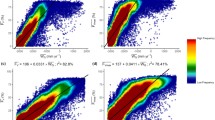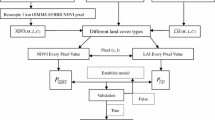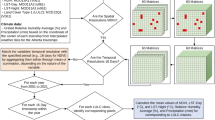Abstract
The article discusses remote methods for the description of the intraseasonal dynamics of soil and vegetation moisture. The field moisture content of the soil and vegetation cover is described by an integral indicator that takes into account the moisture content of the upper soil horizon (5–10 cm), grass phytomass, and leaves of trees and shrubs. The integrated field moisture demonstrates a reliable association with the normalized differential water index (NDWI); the determination coefficient R2 reaches values of 0.91 for individual classes of tracts. The most significant factors determining the loss of moisture during the summer period are the amount of photosynthetically active phytomass, the potential influx of solar radiation during the study period, and the moisture reserve in the soil and vegetation at the beginning of the growing season. These factors describe 67% of the NDWI difference between May and August 2016 in forest areas and 89% in the steppes. The results can be used to search for fire hazardous areas in the steppes and forests, as well as for the monitoring of vineyards.



Similar content being viewed by others
REFERENCES
Böhner, J. and Selige, T., Spatial prediction of soil attributes using terrain analysis and climate regionalization, Göttinger Geogr.Abh., 2006, vol. 115, pp. 13–27.
Carlson, T., An overview of the “triangle method” for estimating surface evapotranspiration and soil moisture from satellite imagery, Sensors, 2007, vol. 7, pp. 1612–1629.
Ceccato, P., Gobron, N., Flasse, S., Pinty, B., and Tarantola, S., Designing a spectral index to estimate vegetation water content from remote sensing data: Part 1. Theoretical approach, Remote Sens. Environ., 2002, vol. 82, pp. 188–197.
Dobson, M.C. and Ulaby, F.T., Active microwave soil moisture research, IEEE Trans. Geosci. Remote Sens., 1985, vol. GE-24, no. 1, pp. 23–36.
Escorihuela, M.J. and Quintana-Seguí, P., Comparison of remote sensing and simulated soil moisture datasets in Mediterranean landscapes, Remote Sens. Environ., 2016, vol. 180, pp. 99–114.
Gao, B.-C., NDWI—A normalized difference water index for remote sensing of vegetation liquid water from space, Remote Sens. Environ., 1996, vol. 58, no. 3, pp. 257–266.
Ghulam, A., Li, Z.-L., Qin, Q., Yimit, H., and Wange, J., Estimating crop water stress with ETM+NIR and SWIR data, Agric. For. Meteorol., 2008, vol. 148, pp. 1679–1695.
Gillon, D., Dauriac, F., Deshayes, M., Valette, J.C., and Moro, C., Estimation of foliage moisture content using near infrared reflectance spectroscopy, Agric. For. Meteorol., 2004, vol. 124, pp. 51–62.
Gorbunov, R.V., Zuev, A.V., and Smirnov, V.O., Water-balance studies in Karadag landscape-ecological stationer, in 100 let Karadagskoi nauchnoi stantsii im. T.I. Vyazemskogo (Collection of Scientific Research Works Dedicated to the 100 Anniversary of Karadag Scientific Station Named after T.I. Vyazemskii), Simferopol: N. Orianda, 2015, pp. 734–747.
Maki, M., Ishiahrab, M., and Tamura, M., Estimation of leaf water status to monitor the risk of forest fires by using remotely sensed data, Remote Sens. Environ., 2004, vol. 90, pp. 441–450.
Moran, M.S., Clarke, T.R., Inoue, Y., and Vidal, A., Estimating crop water deficit using the relation between surface-air temperature and spectral vegetation index, Remote Sens. Environ., 1994, vol. 49, pp. 246–263.
Morozova, A.L. and Vronskii, A.A., Priroda Karadaga (Karadag Nature), Kiev: Naukova Dumka, 1989.
Nijland, W., Coops, N.C., Macdonald, S.E., Nielsen, S.E., Bater, C.W., White, B., Ogilvie, J., and Stadt, J., Remote sensing proxies of productivity and moisture predict forest stand type and recovery rate following experimental harvest, For. Ecol. Manage., 2015, vol. 357, pp. 239–247.
Peuelas, J., Filella, I., Biel, C., Serrano, L., and Sav, R., The reflectance at the 950-970 nm region as an indicator of plant water status, Int. J. Remote Sens., 1993, vol. 14, no. 10, pp. 1887–1905.
Sadeghi, M., Babaeian, E., Tuller, M., and Jones, S.B., The optical trapezoid model: A novel approach to remote sensing of soil moisture applied to Sentinel-2 and Landsat-8 observations, Remote Sens. Environ., 2017, vol. 198, pp. 52–68.
Seneviratne, S.I., Corti, T., Davin, E.L., Hirschi, M., Jaeger, E.B., Lehner, I., Orlowsky, B., and Teuling, A.J., Investigating soil moisture–climate interactions in a changing climate: a review, Earth-Sci. Rev., 2010, vol. 99, nos. 3–4, pp. 125–161.
Shvetsov, E.G., Ruzhichka, Z., and Mironov, V.L., Applicability of SMOS satellite data for evaluation of wild fire danger in Krasnoyarsk krai, Vestn. Sib. Gos. Agrar. Univ., 2013, no. 2 (48), pp. 110–115.
Sysuev, V.V., Fiziko-matematicheskie osnovy landshaftovedeniya (Physical-Mathematical Basis of Landscape Science), Moscow: Mosk. Gos. Univ., 2003.
Transformatsiya landshaftno-ekologicheskikh protsessov v Krymu v XX veke–nachale XXI veka (Transformation of Landscape-Ecological Processes in Crimea in 20th Century–Beginning 21st Century), Simferopol: Dolya, 2010.
Yebra, M., Dennison, P.E., Chuvieco, E., Riaño, D., Zylstra, P., Hunt, E.R., Jr., Danson, F.M., Qi, Y., and Jurdao, S., A global review of remote sensing of live fuel moisture content for fire danger assessment: moving towards operational products, Remote Sens. Environ., 2013, vol. 136, pp. 455–468.
Wigneron, J.-P., Chanzy, A., Calvet, J.-C., and Bruguier, N., A simple algorithm to retrieve soil moisture and vegetation biomass using passive microwave measurements over crop fields, Remote Sens. Environ., 1995, vol. 51, no. 3, pp. 331–341.
Author information
Authors and Affiliations
Corresponding author
Ethics declarations
Conflict of interests. The authors declare that they have no conflicts of interest.
Statement on the welfare of animals. This article does not contain any studies involving animals performed by any of the authors.
Rights and permissions
About this article
Cite this article
Kharitonova, T.I., Surkov, N.V. Landscape Approach to the Modeling of Land-Cover Dynamics with Remote Methods. Arid Ecosyst 10, 10–16 (2020). https://doi.org/10.1134/S2079096120010096
Received:
Revised:
Accepted:
Published:
Issue Date:
DOI: https://doi.org/10.1134/S2079096120010096




